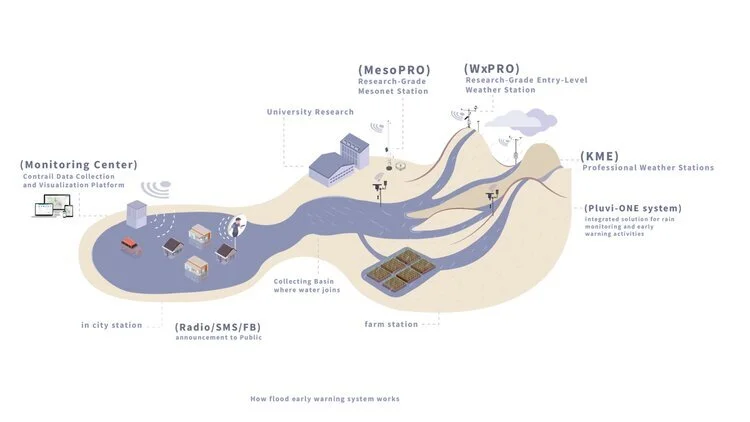Fighting Yemen floods with early warning systems
This year, torrential rains and heavy floods began in Yemen in mid-April and have continued into this May. They are damaging infrastructure, destroying homes, displacing thousands, and causing deaths. Among the most hit governorates are Aden, Ma’rib, Sanaa, Tarib, Hadramaut, Al Dhale’e, Abyan, Lahj, and Ta’iz. Now, with the rainy season running from April to August, Yemen’s National Meteorological Centre has issued flood warnings. Local flood warning systems are therefore critical for early detection and forecasting of potential flood conditions.
Organic Yemen, with its innovative equipment and software and years of expertise, is the perfect partner for setting up these systems for Yemen flood monitoring. This article goes over the importance of environmental monitoring and how Organic Yemen tackles it. It will also present some of our equipment and early flood warning systems and solutions.
Yemen flooding: a growing risk
Floods in Tarim town South Yemen
Every year, flash floods kill dozens of people, displace thousands and destroy property across Yemen. This year alone, according to field reports by OHCA, The UN Humanitarian Agency, the number of families affected by floods rose from 3,730 on 4 May to 6,855 on 9 May.
In Tarim, Hadramaut Governorate, floods have extensively damaged farms and property, killing scores, including a family of three on whom a house collapsed. “People have never seen such heavy flooding for the last three decades”, bemoaned Hadad Mousaid, a resident in Tarim, according to Arab News. The same applies to Mareb and Sanaa governorates where flash floods have killed scores, and destroyed vast infrastructure and properties.
Climate change in Yemen worsens the situation
Climate change meanwhile exacerbates Yemen's flood risks, and indiscriminately increases the vulnerability of Yemen’s food security situation. Indeed, the number of hungry people is projected to increase in the next 50 years.
Although Yemen’s rainy season typically stretches from April to August, there are spatial variations in the impacts of Yemen's climate change. Subsequently, effects on subnational regions and governorates also vary. This makes local flood early warning systems critical, especially in high-risk areas such as Sanaa, Tarim, and Mareb. To set these up, and thereby meet the climate change challenge, Organic Yemen is in discussions with officials all over Yemen.
How flood warning systems work
To start with, it is not possible to prevent floods wholly. However, early warning systems are a critical component of strategies for disaster risk management. They typically issue warnings about an imminent or already occurring flood. This improves people’s preparedness and minimizes threats to people’s safety and infrastructure.
Flood early warning systems comprise integrated elements, including sensing instrumentation, communications equipment, monitoring, and warning service. Whereas small networks have 4-5 stations or rain gauges, you can start with one, and it will still provide alerts and build patterns. Regardless, data needs to be real-time, and usually at short intervals, typically every 10 minutes.
Using sensors, the flood warning system measures rainfall and water levels at upstream points in local area water basins (lakes and rivers). In the same way, it measures levels in flood defenses, including dams, embankments, and dikes. A telemetry system then relays the data from the sensors to a local database. From there, it undergoes processing and analysis, including forecasting and post-event analysis. The final step is for decision and alerting or warning of an impending or occurring flood event. The warning notably includes a prediction for the flood scale, timing, and location, as well as the damages likely to arise from the impending flood.
Organic Yemen early flood warning systems
Organic Yemen has years of experience installing, programming, and maintaining Campbell Scientific (CS) and Lastem equipment.
The Pluvi-ONE
The Pluvi-ONE is an integrated system for monitoring rain and issuing early warnings. It includes a rain gauge, power system, data controller, and a communication part. It uses a rain gauge for producing correct rain measurements in terms of both the amount and the intensity. The system also has other sensors, including temperature, water level, and storm front distance.
Data analysis and communication
The performance of a flood early warning system depends on the seamless integration of hardware, software, and sensors. The software specifically enables real-time operational analytics. It also does continuous monitoring and reporting on the performance of the whole system. The software receives real-time data in the system’s local database via the rainfall sensors or sensors stationed at key upstream parts of the lake or river. The environmental data then undergoes processing, and validation, then analysis.
Graphical displays can show various alarm and historical thresholds
In the process, the system compares a pre-programmed level with the received data level. The accuracy of analysis improves with time as it becomes clearer, how much rain results in a flood event. Once the data received reaches or rises above the particular pre-set level (set threshold), the software immediately sends alerts. This can be through automatic SMS or E-mails to officials. The software also connects to social media, including Facebook and Twitter. It, therefore, updates the public in real-time.
Otherwise, the system ably reduces loads of data into visual displays, presenting complex information in visual charts and graphics that are easy to understand.
What Organic Yemen offers
How early flood warning systems can help minimizing flood consequences
Organic Yemen has the expertise, the equipment, and the experience to address all flood early warning needs. The range of services starts from system planning through purchase, installation, to programming and maintenance of stations. In addition to this, Organic Yemen also has the expertise to configure the analysis software and train staff on how to use it. We are working toward partnerships with local and international partners to save the community and properties during Yemen flood seasons.







